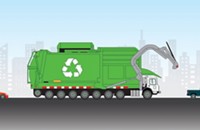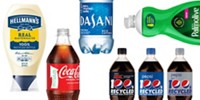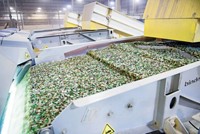Advertisement
Grab your lab coat. Let's get started
Welcome!
Welcome!
Create an account below to get 6 C&EN articles per month, receive newsletters and more - all free.
It seems this is your first time logging in online. Please enter the following information to continue.
As an ACS member you automatically get access to this site. All we need is few more details to create your reading experience.
Not you? Sign in with a different account.
Not you? Sign in with a different account.
ERROR 1
ERROR 1
ERROR 2
ERROR 2
ERROR 2
ERROR 2
ERROR 2
Password and Confirm password must match.
If you have an ACS member number, please enter it here so we can link this account to your membership. (optional)
ERROR 2
ACS values your privacy. By submitting your information, you are gaining access to C&EN and subscribing to our weekly newsletter. We use the information you provide to make your reading experience better, and we will never sell your data to third party members.
Materials
No Second Life
Polypropylene isn't getting recycled nearly as much as its packaging-plastics counterparts
by Michael McCoy
March 16, 2009
| A version of this story appeared in
Volume 87, Issue 11

WHEN ARIEL DEFAZIO opens the refrigerator in her Denver apartment, she sees yogurt, hummus, and margarine, all packaged in containers made of polypropylene. "It's hard to avoid," she says of the ubiquitous plastic.
All that polypropylene frustrates DeFazio, a law student at the University of Colorado, Boulder. She's a passionate recycler, but Denver recycles only plastic bottles, which are typically made of polyethylene terephthalate (PET) and high-density polyethylene (HDPE). As she puts her polypropylene containers in the trash, DeFazio gets peeved at her city's policies and suspicious of the companies that use a packaging material she can't recycle.
Her frustrations are understandable. Thanks to improvements in performance and clarity, polypropylene is showing up more and more in the packaging of nonbottled consumer products. Look in the fridge, and the yogurt, cottage cheese, whipped topping, and takeout food are all likely packaged in polypropylene. In fast-food restaurants, drink cups that were once made from polyethylene or polystyrene are now being made with polypropylene.
But unlike PET and HDPE—known by their resin identification symbols as numbers one and two—polypropylene, plastic number five, can't be recycled by most consumers. And because a wide range of polypropylene grades is used in a variety of containers, replicating the PET and HDPE recycling programs in place across the country isn't going to be easy, experts say.
Scott Saunders shares DeFazio's desire for more polypropylene recycling. He's general manager of KW Plastics, which calls itself the world leader in polypropylene recycling. Today, Saunders gets his resin from spent car batteries and the caps and safety bands found on PET water and soda bottles.
At KW's plant in Troy, Ala., Saunders is already recycling about half a billion pounds of plastics a year. The facility turns ground-up milk jugs and detergent bottles into new polyethylene pellets. It turns used polypropylene into pellets or further processes it into paint containers and other molded products.
According to Saunders, KW's customers want more postconsumer polypropylene, but he doesn't see much emerging from classic curbside recycling programs. "We are contacted regularly by customers looking for postconsumer resin," he says. "The market needs to know that there are ready, willing, and able buyers out there."
Saunders' observations are backed by the American Chemistry Council's plastics division, which just put out its first-ever report on the postconsumer recycling of nonbottle rigid plastics. It sent surveys to 81 materials recycling facilities (MRFs) and concluded that 325 million lbs of nonbottle rigid plastics were collected for recycling in 2007. Some 44% of this was HDPE and 38% was polypropylene. Two-thirds of it was exported, primarily to China.
In contrast, more than 2.3 billion lb of plastic bottles were recovered for recycling in 2007, a companion survey found. Almost all of these bottles were PET or HDPE.
THE REASONS Saunders can't get more postconsumer polypropylene are complex. The collection of postconsumer plastics for recycling is a fractured business with few national players and no national rules. Plastics typically don't bring municipalities the same amount of money as paper, usually the major tonnage material collected from municipal solid waste. Many towns and cities don't even offer plastics recycling, whereas for others it is optional.
"Polypropylene is a problem and an opportunity. Our challenge is to turn that problem into a larger opportunity."
Some places, such as Denver and New York City, collect just plastic bottles—defined as containers in which the neck or opening is smaller than the base. Others go a little further and collect PET and HDPE containers of all types. Relatively few municipalities collect containers or packaging made from polypropylene, polystyrene, or polyvinyl chloride.
Indeed, the ACC survey found that only 28 of the 100 largest U.S. cities collected nonbottle rigid plastics through curbside recycling programs last year. Most of the cities were along the West Coast, where they have easy access to Chinese buyers who, at least until the economic slowdown, were willing to pay more for nonbottle plastics than U.S. buyers.
The Association of Post-Consumer Plastics Recyclers would like to change this. The trade association is forming a committee, called Beyond Bottles, tasked with increasing the recycling of nonbottle rigid packaging.
David Cornell, the association's technical director, has been in the plastics business for a long time, and he's seen the rise of polypropylene as the preferred plastic for making some rigid containers. "The amount of material out there is large, and we know it, but we also know it's not easily identified and isolated," he says.
Plastics picked up during household waste recycling are brought to a MRF. Because different polymers such as polypropylene and polyvinyl chloride have different properties, mixtures of plastics have little value to the recycler. Although a few MRFs have installed infrared sensors that detect different plastics, separation is more often carried out manually by people expected to work quickly for not much pay.
As Cornell explains, the major problem with recycling polypropylene is there's no iconic polypropylene package. "If I ask you to pick out a PET bottle, you will grab a soda bottle, and you will be right 100% of the time," he says. Similarly, milk jugs and laundry detergent bottles are almost always made of HDPE.
"Hand pickers at a MRF have one-tenth of a second to make a decision," Cornell says, "so they are looking for the iconics." In contrast, margarine tubs, yogurt containers, and the like come in all shapes and sizes. And although they are more likely to be made of polypropylene these days, polyethylene and polystyrene are still used. To avoid mistakes, Cornell says, workers in recycling plants generally let them continue down the sorting line and into bins of mixtures destined for China, an incinerator, or a landfill.
THINGS ARE starting to change, albeit slowly. Pulled by demand for cheap recycled plastic and pushed by noisy consumers, the recycling infrastructure is slowly embracing polypropylene.
One sign of change is an alternative system for collecting the plastic set up by several companies that appeal to eco-conscious consumers. In January, Preserve Products, a maker of household products molded from recycled polypropylene, launched a collection program in collaboration with Whole Foods supermarkets, the organic yogurt maker Stonyfield Farm, and the farmer-owned cooperative Organic Valley.
Under the program, called Gimme 5, any empty plastic container stamped with the number five symbol can be brought to a Whole Foods store and thrown into a special bin. Preserve will collect them for conversion into toothbrushes, disposable razors, kitchen utensils, and the like. Preserve, based in Waltham, Mass., says it commissioned a life-cycle assessment that found recycled polypropylene generates 80% less carbon dioxide and uses 67% less water than virgin polypropylene.
John Lively, Preserve's director for environmental and material science, says he's stepping into the new program cautiously. For the past eight years, Preserve's main raw materials have been rejected yogurt cups from companies like Stonyfield and leftover containers from a local hummus manufacturer.
Shaping even these fairly homogeneous raw materials into colanders and cutting boards is challenging, Lively says, and has required the help of plastics engineers at the University of Massachusetts, Lowell. The plastics that will come back from Whole Foods will be of an even wider variety of colors and melt properties, he acknowledges.
COLLECTION will have to move beyond a niche program like Preserve's if polypropylene recycling is to get anywhere near the billions of pounds reported for PET and HDPE. The next stage needs to be at the nation's MRFs, where polypropylene is starting to garner attention.
In 2003, when trash giant Waste Management opened a multi-million-dollar plastic bottle recycling center in Raleigh, N.C., polypropylene wasn't a consideration. But prompted by growth in the amount of number five coming through, the firm subsequently retrofitted the facility to process polypropylene.
Dwight King, who oversees the Raleigh facility for Waste Management, describes a high-tech Rube Goldberg machine in which big bales of bottles are cracked open, metal is removed with magnets and eddy currents, and plastics are separated with infrared-based optical scanning and jets of air. HDPE is blown out first, then further separated into plain and pigmented streams. PVC comes next, followed by PET, which also is separated into clear and colored streams.
Polypropylene comes out at the end of the line. According to King, of the 9 million lbs-plus of plastic he processes each month, 3 to 4% is polypropylene. It's baled up and sent to customers for further processing.
As a means of quality control, King explains, Waste Management designed the facility to handle only bottles. Broadening the stream to include other rigid containers would introduce a wider range of materials and an even more complex recycling process.
Yet the company would recover more polymer—particularly polypropylene—if it processed nonbottle plastics, King acknowledges. "That's the way the industry is going," he says. "There will be obstacles, but that's what growth in this industry is about—overcoming obstacles."
Preserve Products' Lively says the industry could overcome the obstacles of color and melt flow with more standardization. Cornell, from the recycling group, sees impetus coming from big brand owners that want to appeal to eco-conscious consumers. A Procter & Gamble executive, he notes, is helping get Beyond Bottles off the ground.
"The recycling business is very entrepreneurial and things change quickly," Cornell says. "Polypropylene is a problem and an opportunity. Our challenge is to turn that problem into a larger opportunity."






Join the conversation
Contact the reporter
Submit a Letter to the Editor for publication
Engage with us on Twitter